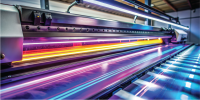By Debbie Nicholson, Think-to-INK!
https://www.linkedin.com/in/debbie-nicholson-24a53627/
The Untold Story of UV Printing!
I have been in the print industry longer than I would like to admit; alright, alright already, 30+ years—there, I said it! However, that doesn’t make me an ink expert by any means. I know ink speak (i.e., toner, offset, heat-set, cold-set, flexo, solvent, aqueous, eco-solvent, sublimation, latex, gel, UV-curable, and many more). But I want to make today's point about UV-curable printing (ultraviolet).
Did you know UV printing was invented in the early 1970s? At the time, it was only used for printing bar codes and packaging labels, as the equipment was less extensive than it is today.
But hold on. In the mid-2000s, the development of curing gel nail polish with UV light laid the groundwork for UV printing technology in the printing industry. The fast-drying, long-lasting, and flawless manicure results highlight the benefits of UV ink-curing. Eventually, UV printing technology began its journey into the printing industry for commercial and industrial applications, and it has grown in popularity ever since.
 Who knew that spending all that time in salons with our fingers stuck in a heated little contraption would become such a groundbreaking innovation for the printing industry? So, when you need to leave work early for a salon appointment, tell your boss it’s in the name of
Who knew that spending all that time in salons with our fingers stuck in a heated little contraption would become such a groundbreaking innovation for the printing industry? So, when you need to leave work early for a salon appointment, tell your boss it’s in the name of science printing!
UV printing technology has changed the printing industry.
When we purchased our first grand-format printer, the inks were solvent-based! In short, this means that when the inks were cured with a heat bar, they released an unpleasant odor into the air, known as volatile organic compounds (VOCs), ozone, or toxic fumes. Without hesitation, we placed our equipment in a closed-off room and installed a powerful ventilation system to keep our employees safe.
So, look at the industry now. We can print with specialized UV inks, and instead of heat, we use high-intensity LED ultraviolet lights to cure the ink onto substrates. The ultraviolet light travels closely behind the ink as it is distributed onto the substrate, drying it immediately. Zap!
Let’s unpack how UV printing offers countless benefits:
- Improved turn-around time(s) due to instant ink drying ability means faster output
- UV-cured inks are more resistant to scratches, scuffs, and marks.
- The inks are brighter and cleaner than traditional printing methods.
- Color consistency and measurably higher print quality
- Eco-friendly as the UV inks and curing process together release virtually no VOCs
- Increased possibilities, as UV printers can print on almost every material thanks to UV-curing
 The answer is yes when asked if UV printing is more expensive than other printing processes. LED lights, inks, and advanced technologies are costly to engineer, create, and manufacture. However, if you consider just a few of the benefits listed above, I know you will come to the same conclusion that many printing companies already have: It’s just plain worth it!
The answer is yes when asked if UV printing is more expensive than other printing processes. LED lights, inks, and advanced technologies are costly to engineer, create, and manufacture. However, if you consider just a few of the benefits listed above, I know you will come to the same conclusion that many printing companies already have: It’s just plain worth it!
The intrigue: here are products made with UV printing and much more!
- Glassware: coffee mugs, water bottles
- Linens: such as pillow-cases, pillows, sheets, blankets, comforters, and quilts
- Holiday décor: ornaments, plaques, plastic elements,
- Writing utensils: pens, mechanical pencils, markers, crayons, stylus, brushes
- Décor: Acrylic Wall Décor, Canvas Prints, Wood Prints, Metal Prints
- Signage: Interior Branding, Exterior Branding, Backlit Signage, Channel Lettering
- Wayfinding signs: Parking Garages, Parking Lots, Hospitality, Health Care, Education
- Wall Covering: Murals, Environmental Graphics, Sports Programs, Arenas
Elevate your relevance when purchasing equipment.
It’s not about how big your shop is or how many pieces of equipment you have; it’s about how well your equipment works for you!


Prefer to comment without registration? Click in the Name field and select "I'd rather post as a guest"